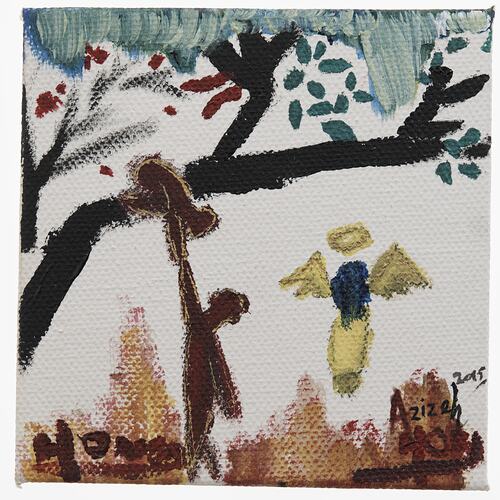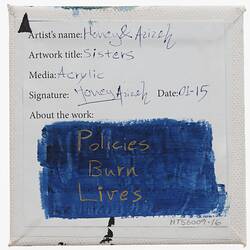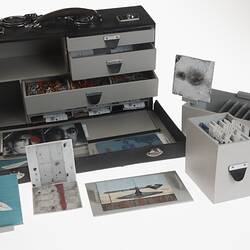Summary
Artwork entitled 'Sisters', created in 2015 by Melbourne-based Iranian refugees, Honey & Azizeh Astaneh. It is a part of 'Attache Case', a collective artwork co-ordinated by Peter Burke in 2015. Azizeh also created two other artworks in this collection: 'Me, The Living' (HT56009.15) and 'AZIZEH' (HT56009.6).
Artist statement provided by Azizeh in 2021: 'I see that art has played a vital and important role in my life, not just my life but in other lives as well. I see myself as a voice, not just for my experience. It has not been my experience only, it's been the experience that I have shared with many others.'
Azizeh, originally from Iran, came to Australia with her mother and two siblings in 2013. Before embarking on a degree in Electrical and Electronic Engineering (Honours) at Victoria University ( in her third year in 2022), she studied graphic design and business administration at Victoria University Polytechnic. She also co-founded the Melbourne Artists for Asylum Seekers, a volunteer-run organisation dedicated to hosting art workshops for asylum seekers inside and outside of detention (2013-2019).
Having witnessed and lived through the experience of gender inequalities, her goal is to become a role model for other women in the fields of Science, Technology, Engineering and Mathematics (STEM) and empower the next generation of women into leadership roles. Azizeh has been working full-time at the Rail Infrastructure Alliance on the Metro Tunnel Project since 2020.
This collective artwork, entitled 'Attache Case' (HT56009), was created by Melbourne artist, curator and lecturer Peter Burke in 2015 as part of an international touring art installation, 'Low-Cost Diplomatic Bag', auspiced by the Spanish Embassy, and curated by Nilo Casares and ArtEx Madrid. It travelled to the Spanish Embassies in five countries, including Australia, in 2015-2016 (one venue included Immigration Museum, Melbourne). 'Attache Case' is comprised of a re-purposed doctor's medical case which opens to reveal small drawers containing 41 individuals' miniature artworks representing 21 refugees from Afghanistan, Vietnam, Poland, Colombia, Sri Lanka, Iran, Egypt and Iraq.
The artworks inside the case are acrylic and oil paintings and collage works on canvas board and copper. Many artworks have handwritten descriptions on paper by the artists on the reverse. The collection also includes a video about the project by César Espada produced in 2015.
Physical Description
Acrylic on canvas board. Yellow winged blue angel figure beside a brown child figure climbing down from a tree into the arms of an embracing mother figure onto the firey ground under a tree and blue skies.
Significance
'Attache Case' is a collective artwork created in 2015 in response to an invitation by artist, Peter Burke, to a number of asylum seekers and refugees in Melbourne to express their experience visually. The refugees and asylum seekers (some in detention at the time of the project) who produced the artworks came from diverse countries including Afghanistan, Vietnam, Poland, Hungary, Colombia, Sri Lanka, Iran, Egypt and Iraq. They explore diverse themes relating to detainment, immigration, border security policies, bureaucracy, and mental health.
The artists convey thoughts and feelings about freedom, opprtunities, life in Australia, resettlement, optimism, despair, grief, hope, fear and anger and the consequences of living in limbo. These refugee and asylum seeker's voices, concerns, and personal perspectives are not often publicly expressed and more often manipulated by media and politics or silenced in their community.
This complex artwork contains a diversity of cultures, genders, experiences, artistic styles, and responses. The oil and acrylic paintings are objects rich with symbolic meaning - both as a part of a luggage item reminiscent of the migrant experience, as well as a traveller's borderless container (representing migration, diplomacy, policy and bureaucracy) of voices that speak to the issues that are at the heart of the asylum seeker situation and debate.
More Information
-
Collecting Areas
-
Artist
-
Creator
-
Inscriptions
Reverse side [handwritten]: 'Honey & Azizeh/'Sisters'/'Acrylic'/'Honey Azizeh'/01-15/'Policies'/'Burn'/'Lives.'/
-
Classification
-
Category
-
Discipline
-
Type of item
-
Overall Dimensions
100 mm (Length), 100 mm (Width)
-
Keywords
Refugees, Artists, Artistic Practices, Artworks, Immigration Debates, Immigration Selection, Immigration, Luggage, Detention Centres, Activism, Politics, Ethnic Groups, Iranian Communities, Iranian Immigration



